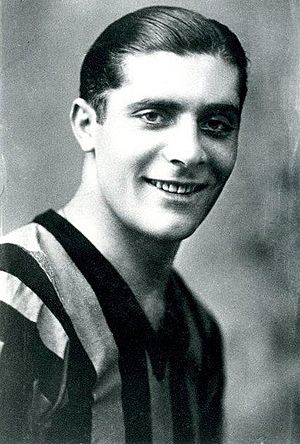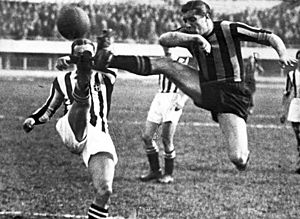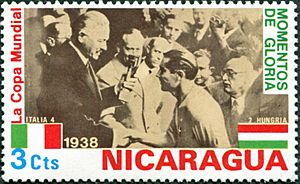Giuseppe Meazza facts for kids

Meazza during the 1934–1935 season with Ambrosiana
|
|||||||||||||||||||||||||||||||
| Personal information | |||||||||||||||||||||||||||||||
|---|---|---|---|---|---|---|---|---|---|---|---|---|---|---|---|---|---|---|---|---|---|---|---|---|---|---|---|---|---|---|---|
| Date of birth | 23 August 1910 | ||||||||||||||||||||||||||||||
| Place of birth | Milan, Italy | ||||||||||||||||||||||||||||||
| Date of death | 21 August 1979 (aged 68) | ||||||||||||||||||||||||||||||
| Place of death | Lissone, Italy | ||||||||||||||||||||||||||||||
| Height | 1.69 m (5 ft 7 in) | ||||||||||||||||||||||||||||||
| Position(s) | Forward | ||||||||||||||||||||||||||||||
| Youth career | |||||||||||||||||||||||||||||||
| 1922–1924 | Gloria | ||||||||||||||||||||||||||||||
| 1924–1927 | Inter Milan | ||||||||||||||||||||||||||||||
| Senior career* | |||||||||||||||||||||||||||||||
| Years | Team | Apps | (Gls) | ||||||||||||||||||||||||||||
| 1927–1940 | Inter Milan | 348 | (240) | ||||||||||||||||||||||||||||
| 1940–1942 | Milan | 37 | (9) | ||||||||||||||||||||||||||||
| 1942–1943 | Juventus | 27 | (10) | ||||||||||||||||||||||||||||
| 1944 | Varese | 20 | (7) | ||||||||||||||||||||||||||||
| 1945–1946 | Atalanta | 14 | (2) | ||||||||||||||||||||||||||||
| 1946–1947 | Inter Milan | 17 | (2) | ||||||||||||||||||||||||||||
| Total | 463 | (270) | |||||||||||||||||||||||||||||
| International career | |||||||||||||||||||||||||||||||
| 1930–1939 | Italy | 53 | (33) | ||||||||||||||||||||||||||||
| Managerial career | |||||||||||||||||||||||||||||||
| 1946 | Atalanta | ||||||||||||||||||||||||||||||
| 1946–1948 | Inter Milan | ||||||||||||||||||||||||||||||
| 1948–1949 | Beşiktaş | ||||||||||||||||||||||||||||||
| 1949–1951 | Pro Patria | ||||||||||||||||||||||||||||||
| 1952–1953 | Italy Olympic | ||||||||||||||||||||||||||||||
| 1955–1956 | Inter Milan | ||||||||||||||||||||||||||||||
| 1957 | Inter Milan | ||||||||||||||||||||||||||||||
|
Medal record
|
|||||||||||||||||||||||||||||||
| *Club domestic league appearances and goals | |||||||||||||||||||||||||||||||
Giuseppe "Peppino" Meazza (born August 23, 1910 – died August 21, 1979) was a famous Italian football player and manager. He is known as one of the greatest footballers of all time. Many people in Italy think he was the best Italian player ever.
Meazza played mostly for Inter Milan in the 1930s. He scored an amazing 242 goals in 365 games for the club. He helped Inter win three Serie A titles and the Coppa Italia. He also played for other big Italian clubs like Milan and Juventus.
He was a key player for the Italian national team. He led Italy to win two World Cups in a row. First, in 1934 when Italy hosted the tournament. Then, in 1938, he was the team's captain.
After he stopped playing, Meazza became a coach. He coached the Italian national team and several club teams. The main stadium in his hometown of Milan, San Siro, was renamed Stadio Giuseppe Meazza in his honor. This happened on March 3, 1980.
Contents
Giuseppe Meazza's Early Life
Giuseppe Meazza was born in Milan, Italy. When he was only seven years old, his father died in World War I. Giuseppe grew up helping his mother sell fruit in the market.
He started playing football at six years old. He played barefoot with a ball made of rags on the streets. When he was twelve, his mother let him try to become a professional footballer. He joined a team called Gloria F.C. A fan even gave him his first pair of football boots!
At 14, Meazza wanted to play for Milan. But they thought he was too small. Luckily, their city rivals, Inter Milan, accepted him.
His older teammate, Leopoldo Conti, gave him the nickname "il Balilla". This means "The Little Boy". Meazza was only 17 when he joined the senior team. Conti thought he was too young. But Meazza scored two goals in his first official game. This left Conti very surprised!
Meazza's Amazing Club Career

Starring at Inter Milan
Giuseppe Meazza scored two goals in his first professional game. This was on September 12, 1927. The next day, a sports newspaper called his play "intelligent, fresh, quick".
Meazza still holds a record for scoring the most goals in a debut season in Serie A. He scored 31 goals in his first season (1929–30). He once scored five goals in a single game, and even six goals in another game!
With Meazza, Inter Milan won three national championships: in 1930, 1938, and 1940. He also helped them win their first Coppa Italia in 1939. He was the top scorer in Serie A three times. He was also the top scorer in the Mitropa Cup three times.
Playing for Other Big Clubs
Meazza got injured in 1938, which kept him out of many games. After spending most of his career at Inter, he moved to A.C. Milan in 1940. Later, he also played for Juventus, Varese, and Atalanta. His last season scoring many goals was with Juventus in 1942–43. After this, leagues were stopped because of World War II.
Coming Back to Inter
In 1946, Meazza returned to Inter Milan as a player-coach. He played 17 more games and scored two goals. These goals helped Inter avoid being moved to a lower league.
Winning with Italy: World Cup Glory
Meazza played for the Italian national team in the 1934 and 1938 World Cups. Italy won both of these tournaments! He was also the captain of the team that won in 1938. He is one of only four Italian players to win two World Cups.
His First Games for Italy
His first game for Italy was on February 9, 1930, against Switzerland. Meazza, who was 19, scored two goals in that game. Italy won 4–2. A few months later, he scored three goals in a 5–0 win against Hungary. He helped Italy win the Central European International Cup that year.
The 1934 World Cup Win
Italy hosted the 1934 FIFA World Cup. Meazza played in every game. He scored two goals in a qualifying match against Greece. He also scored a goal in Italy's 7–1 win over the United States. In the quarter-final against Spain, Meazza scored the only goal in a replay game.
In the final against Czechoslovakia, the score was 1–1 after 90 minutes. In extra time, Meazza helped set up the winning goal. Italy won the World Cup! Meazza was chosen for the tournament's All-Star Team. He also won the Golden Ball award for the best player.
The 1938 World Cup as Captain
In the 1938 FIFA World Cup in France, Meazza was the captain of Italy. He played in every match again. In the semi-final against Brazil, Italy got a penalty kick. As Meazza went to take it, his shorts fell down because the elastic ripped! He held them up with one hand and still scored the goal. Italy won 2–1.
In the final, Italy played Hungary. Meazza helped set up two goals for his teammates. Italy won the World Cup for the second time in a row! His teammate, Silvio Piola, said Meazza was responsible for his own good performance.
Meazza played his last game for Italy in 1939. He played 53 times for Italy and scored 33 goals. He is still Italy's second-highest goal scorer ever.
How Meazza Played: His Unique Style
Meazza started as a striker but later played as a creative forward. He could also play as an attacking midfielder or even a playmaker. He was known for his amazing shooting and dribbling skills. He was also great at passing the ball. Even though he wasn't very tall, he was excellent at heading the ball. He was also a great leader on the field.
Meazza was one of the first Italian footballers to become famous worldwide. He was also the first player to have personal sponsors. He was known for his exciting style both on and off the field. He had a soft touch on the ball and could make defenders panic.
He was a superb dribbler. He could create many chances for his teammates and score goals himself. His bending shots, called "dead leaf technique" goals, were feared by goalkeepers. He was also a brilliant passer with great vision.
His most famous goals involved him picking up the ball in the middle of the field. He would dribble past several opponents with fancy moves. Then, he would stop in front of the goal, trick the goalkeeper, dribble past them, and easily score. Italian football fans still use phrases like "Gol alla Meazza" to describe amazing dribbling goals.
Life After Football and Legacy
Giuseppe Meazza died on August 21, 1979, just two days before his 69th birthday. He is buried in Milan.
Meazza was one of the first Italians to coach a team outside Italy. He coached Beşiktaş J.K. in Turkey. He also helped young players at Inter Milan. He is in the Italian Football Hall of Fame. Many experts believe he was the best Italian player ever.
The San Siro stadium in Milan, which is home to Inter Milan and AC Milan, was renamed Stadio Giuseppe Meazza in his honor.
Career Stats
Club
| Season | Club | League | Cup | Europe | Other | Total | ||||||
|---|---|---|---|---|---|---|---|---|---|---|---|---|
| Division | Apps | Goals | Apps | Goals | Apps | Goals | Apps | Goals | Apps | Goals | ||
| Inter Milan | 1927–28 | Divisione Nazionale | 33 | 12 | 33 | 12 | ||||||
| 1928–29 | Divisione Nazionale | 29 | 33 | 29 | 33 | |||||||
| 1929–30 | Serie A | 33 | 31 | 33 | 31 | |||||||
| 1930–31 | Serie A | 34 | 24 | 6 | 7 | 40 | 31 | |||||
| 1931–32 | Serie A | 28 | 21 | 28 | 21 | |||||||
| 1932–33 | Serie A | 32 | 20 | 32 | 20 | |||||||
| 1933–34 | Serie A | 32 | 21 | 6 | 5 | 38 | 26 | |||||
| 1934–35 | Serie A | 30 | 18 | 2 | 3 | 32 | 21 | |||||
| 1935–36 | Serie A | 29 | 25 | 2 | 1 | 2 | 2 | 33 | 28 | |||
| 1936–37 | Serie A | 26 | 11 | 4 | 3 | 6 | 10 | 36 | 24 | |||
| 1937–38 | Serie A | 26 | 20 | 4 | 8 | 30 | 28 | |||||
| 1938–39 | Serie A | 16 | 4 | 6 | 0 | 4 | 2 | 26 | 6 | |||
| 1939–40 | Serie A | 0 | 0 | 1 | 0 | 1 | 0 | |||||
| Total | 348 | 240 | 16 | 12 | 27 | 29 | 391 | 282 | ||||
| Milan | 1940–41 | Serie A | 14 | 6 | 1 | 0 | 15 | 6 | ||||
| 1941–42 | Serie A | 23 | 3 | 4 | 2 | 27 | 5 | |||||
| Juventus | 1942–43 | Serie A | 27 | 10 | 27 | 10 | ||||||
| Varese | 1944 | Alta Italia | 20 | 7 | 20 | 7 | ||||||
| Atalanta | 1945–46 | Divisione Nazionale | 14 | 2 | 14 | 2 | ||||||
| Inter Milan | 1946–47 | Serie A | 17 | 2 | 17 | 2 | ||||||
| Career total | 463 | 270 | 21 | 14 | 27 | 29 | 511 | 313 | ||||
International
| National team | Year | Apps | Goals |
|---|---|---|---|
| Italy | 1930 | 5 | 6 |
| 1931 | 6 | 5 | |
| 1932 | 4 | 2 | |
| 1933 | 5 | 5 | |
| 1934 | 9 | 7 | |
| 1935 | 3 | 2 | |
| 1936 | 4 | 2 | |
| 1937 | 5 | 1 | |
| 1938 | 6 | 3 | |
| 1939 | 6 | 0 | |
| Total | 53 | 33 | |
- Scores and results list Italy's goal tally first, score column indicates score after each Meazza goal.
| No. | Date | Venue | Opponent | Score | Result | Competition |
|---|---|---|---|---|---|---|
| 1 | 9 February 1930 | Stadio Nazionale PNF, Rome, Italy |
|
4–2 | Friendly | |
| 2 |
|
|||||
| 3 | 2 March 1930 | Waldstadion, Frankfurt, Germany |
|
2–0 | Friendly | |
| 4 | 11 May 1930 | Üllői úti stadion, Budapest, Hungary |
|
5–0 | 1927-30 Central European International Cup | |
| 5 |
|
|||||
| 6 |
|
|||||
| 7 | 25 January 1931 | Stadio Littoriale, Bologna, Italy |
|
5–0 | Friendly | |
| 8 |
|
|||||
| 9 |
|
|||||
| 10 | 22 February 1931 | San Siro, Milan, Italy |
|
2–1 | 1931-32 Central European International Cup | |
| 11 | 20 May 1931 | Stadio Nazionale PNF, Rome, Italy |
|
3–0 | Friendly | |
| 12 | 20 March 1932 | Praterstadion, Vienna, Austria |
|
1–2 | 1931-32 Central European International Cup | |
| 13 | 27 November 1932 | San Siro, Milan, Italy |
|
4–2 | Friendly | |
| 14 | 1 January 1933 | Stadio Littoriale, Bologna, Italy |
|
3–1 | Friendly | |
| 15 | 12 February 1933 | King Baudouin Stadium, Brussels, Belgium |
|
3–2 | Friendly | |
| 16 |
|
|||||
| 17 | 2 April 1933 | Charmilles Stadium, Geneva, Switzerland |
|
3–0 | 1933-35 Central European International Cup | |
| 18 | 3 December 1933 | Stadio Comunale, Florence, Italy |
|
5–2 | 1933-35 Central European International Cup | |
| 19 | 25 March 1934 | San Siro, Milan, Italy |
|
4–0 | 1934 FIFA World Cup qualifier | |
| 20 |
|
|||||
| 21 | 27 May 1934 | Stadio Nazionale PNF, Rome, Italy |
|
7–1 | 1934 FIFA World Cup | |
| 22 | 1 June 1934 | Stadio Comunale, Florence, Italy |
|
1–0 | 1934 FIFA World Cup | |
| 23 | 14 November 1934 | Highbury stadium, London, England |
|
2–3 | Friendly | |
| 24 |
|
|||||
| 25 | 9 December 1934 | San Siro, Milan, Italy |
|
4–2 | Friendly | |
| 26 | 17 February 1935 | Stadio Nazionale PNF, Rome, Italy |
|
2–1 | Friendly | |
| 27 |
|
|||||
| 28 | 31 May 1936 | Hungária körúti stadion, Budapest, Hungary |
|
2–1 | Friendly | |
| 29 | 25 October 1936 | San Siro, Milan, Italy |
|
4–2 | 1936-38 Central European International Cup | |
| 30 | 27 May 1937 | Ullevaal Stadion, Oslo, Norway |
|
3–1 | Friendly | |
| 31 | 15 May 1938 | San Siro, Milan, Italy |
|
6–1 | Friendly | |
| 32 | 22 May 1938 | Stadio Luigi Ferraris, Genoa, Italy |
|
4–0 | Friendly | |
| 33 | 16 June 1938 | Stade Vélodrome, Marseille, France |
|
2–1 | 1938 FIFA World Cup |
Awards and Achievements
Inter Milan
- Serie A: 1929–30, 1937–38, 1939–40
- Coppa Italia: 1938–39
Italy
- FIFA World Cup: 1934, 1938
- Central European International Cup: 1927–30, 1933–35
- Central European International Cup: Runner-up: 1931-32
Individual Awards
- Serie A top goalscorer: 1929–30, 1935–36, 1937–38
- Mitropa Cup top goalscorer: 1930, 1933, 1936
- FIFA World Cup Golden Ball: 1934 (Best Player)
- FIFA World Cup All-Star Team: 1938
- Inducted into the Italian Football Hall of Fame (2011)
- Inducted into the Walk of Fame of Italian sport: 2015
- Inter Milan Hall of Fame: 2019
Images for kids
See also
 In Spanish: Giuseppe Meazza para niños
In Spanish: Giuseppe Meazza para niños




